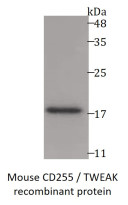ARG70406
Mouse CD255 / TWEAK recombinant protein (Active) (His-tagged, C-ter)
Mouse CD255 / TWEAK recombinant protein (Active) (His-tagged, C-ter) for SDS-PAGE
Overview
| Product Description | E. coli expressed, His-tagged (C-ter) Active Mouse CD255 / TWEAK recombinant protein |
|---|---|
| Tested Application | SDS-PAGE |
| Target Name | CD255 / TWEAK |
| Species | Mouse |
| A.A. Sequence | His110 - His249 |
| Expression System | E. coli |
| Protein Full Name | Tumor necrosis factor ligand superfamily member 12 |
| Activity | Active |
| Activity Note | Determined by its ability to induce proliferation in HUVEC cells. The ED50 for this effect is < 0.2 μg/mL. |
| Alternate Names | TNFSF12; TNF Superfamily Member 12; TWEAK; DR3LG; APO3L; Tumor Necrosis Factor (Ligand) Superfamily, Member 12; Tumor Necrosis Factor Ligand Superfamily Member 12; APO3 Ligand; Tumor Necrosis Factor Superfamily Member 12; TNF-Related WEAK Inducer Of Apoptosis; TNF-Related Weak Inducer Of Apoptosis; Tumor Necrosis Factor Ligand 4A; APO3/DR3 Ligand; TNLG4A |
Properties
| Form | Powder |
|---|---|
| Purification Note | Endotoxin level is less than 0.1 EU/µg of the protein, as determined by the LAL test. |
| Purity | > 98% (by SDS-PAGE) |
| Buffer | PBS (pH 7.4) |
| Reconstitution | It is recommended to reconstitute the lyophilized protein in sterile water to a concentration not less than 200 μg/mL and incubate the stock solution for at least 20 min at room temperature to make sure the protein is dissolved completely. |
| Storage Instruction | For long term, lyophilized protein should be stored at -20°C or -80°C. After reconstitution, aliquot and store at -20°C or -80°C for up to one month. Storage in frost free freezers is not recommended. Avoid repeated freeze/thaw cycles. Suggest spin the vial prior to opening. |
| Note | For laboratory research only, not for drug, diagnostic or other use. |
Bioinformation
| Gene Symbol | TNFSF12 |
|---|---|
| Gene Full Name | TNF Superfamily Member 12 |
| Background | The protein encoded by this gene is a cytokine that belongs to the tumor necrosis factor (TNF) ligand family. This protein is a ligand for the FN14/TWEAKR receptor. This cytokine has overlapping signaling functions with TNF, but displays a much wider tissue distribution. This cytokine, which exists in both membrane-bound and secreted forms, can induce apoptosis via multiple pathways of cell death in a cell type-specific manner. This cytokine is also found to promote proliferation and migration of endothelial cells, and thus acts as a regulator of angiogenesis. Alternative splicing results in multiple transcript variants. Some transcripts skip the last exon of this gene and continue into the second exon of the neighboring TNFSF13 gene; such read-through transcripts are contained in GeneID 407977, TNFSF12-TNFSF13. |
| Function | Binds to FN14 and possibly also to TNRFSF12/APO3. Weak inducer of apoptosis in some cell types. Mediates NF-kappa-B activation. Promotes angiogenesis and the proliferation of endothelial cells. Also involved in induction of inflammatory cytokines. Promotes IL8 secretion. |
| Cellular Localization | Cell membrane, Membrane, Secreted |
| PTM | Cleavage on pair of basic residues, Disulfide bond, Glycoprotein |
Images (1) Click the Picture to Zoom In






